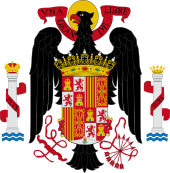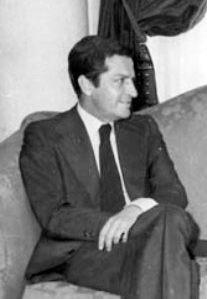Political Reform Act
This article needs additional citations for verification. (April 2017) |
| Political Reform Act | |
|---|---|
 | |
| Cortes Españolas | |
| Enacted by | 10th Cortes Españolas |
| Enacted | 18 November 1976 |
| Royal assent | 4 January 1977 |
| Effective | 5 January 1977 |
| Repealed | 29 December 1978 |
| Status: Repealed | |

The Political Reform Act (Act 1/1977, of January 4, for the Political Reform)[1] was adopted on November 18, 1976 by the Spanish Parliament with the support of 435 out of 531 members (81% in favor) that formed the legislature, and submitted to a referendum with a participation of the 77,8% of the census and with 94,17% of the votes in favor.[2] It had the status of Fundamental Law, being the last one of the Fundamental Laws of the Francoist State. The Act was repealed by the Spanish Constitution in 29 December 1978.
Background[]
Seven political associations, constituted thanks to the Political Associations Act of 1976, enacted during the government of Arias Navarro to support in democracy to the so-called sociological Francoism, they founded on October 9, 1976 a new political party, Alianza Popular (AP). Their leaders were Manuel Fraga, Licinio de la Fuente, , Laureano López Rodó, Gonzalo Fernández de la Mora, and Cruz Martínez Esteruelas. Both Adolfo Suárez and Torcuato Fernández-Miranda were prepared to dissolve the Spanish Cortes in the event of opposition, since his term had been fulfilled.[3]
After the bill was approved by the Council of Ministers, it was submitted to the National Council of the Movement and it was approved on October 16 by 80 votes in favor, 13 against and 6 abstentions. This body prolonged its own dissolution:
... The present bill, which pretends and seeks, preferably, that the popular majority is constituted as a decisive instance of the reform, only incardinating in the current political order can find a source and basis for its legitimate propounding...
Content[]
The Political Reform Act was the legal instrument that allowed the Spanish Transition to be carried out within the dictatorial system established by General Francisco Franco. This law established a parliamentary monarchy under Juan Carlos I, and eventually led to a referendum to approve the Constitution of 1978.
The act is divided in five primary articles, three transitory articles (which regulate some legal situations in a provisional way) and a final disposition.[1]
- The first two primary articles regulate the form of the state (democracy, popular sovereignty, fundamental rights...), the legislative power, universal suffrage and the role of the King.
- The third and the fourth primary articles regulates the way that the constitutional reforms projects are handled between the Congress and the Senate.
- The fifth primary article regulates the referendums.
- The first transitory article regulates the way how the elections are going to work, with the number of deputies and senators, the people that can vote and electoral districts.
- The second and the third transitory articles regulate the moments after the elections, including how both legislative chambers are going to be organized, and the rules that will govern both chambers until the approval of new ones.
The final disposition clarifies that the act will have the level of a fundamental law.
Parliamentary process[]
Since the first moment, President Suarez wanted to approve the act legally. His party defended the approval of the act in the Spanish legislature. The debate about the act started on November 16 and ended on November 18.[4]
The first prosecutor to defend the act was Miguel Primo de Rivera and Urquijo along with Fernando Suárez González, the first representative of the lecture. The next day, November 17, was the turn of the prosecutors, who gave arguments in favour and against. The last day, November 18, was the responses of the impellers.
One of the most difficult moments was the intervention of against the act:
“The Reform project is in conflict with the political philosophy of the State (...), this Reformation, as the Government wants it, and as the paper defends it, is a rupture, although the rupture is wanted to do with out violence and with legality.”
Voting[]
The act was voted at 09:35 PM of November 18, 1976. It had 425 votes in favour, 59 against, and 13 abstentions. This voting and the consequent approval is known as the «harakiri of the Francoist Cortes»
The final words of the official approval of the Act were:[4]
«The President of the Congress: Mr. Secretary is going to read the results of the voting.
The Secretary of the Congress: Total number of prosecutors that forms the Chámber: 531.
Numbers of prosecutors that constitute the absolute majority: 267.
Total number of present prosecutors: 497.
Quorum of the two thirds of the presents: 330. Affirmative votes: 425.
Negative votes: 59. Abstentions: 13.
The President of the Congress: The bill has been approved. The sitting is closed.»
Referendum[]

This Act, after the approval of the Spanish Courts, was submitted to referendum on December 18, 1976. The participation was 77,8% of the census and with a 94,17% votes in favor.[2]
Consequences[]
The approval of this law is seen as the political transformation of the country, turning Spain into a democracy, with a parliamentary monarchy and with the rule of law as one of the fundamental principles of the State.
This law also gives sovereignty to the people and a variety of rights, which would later be developed by the Constitution of 1978. Another principle that this law established is the separation of powers, all of which were previously concentrated in the person of the dictator and are now divided between the government (executive power), the courts (judicial power) and the parliament or Cortes Generales (legislative power).[5][6]
References[]
- ^ a b Law 1/1977, of January 4, of the Political Reform Boletín Oficial del Estado. January 5, 1977.
- ^ a b Nohlen, D & Stöver, P (2010) Elections in Europe: A data handbook, p1824 ISBN 978-3-8329-5609-7
- ^ Decree 1823/1975, of July 31, which extends the current Legislature of the Spanish Courts.
- ^ a b Manuel Contreras Casado and Enrique Cebrián Zazurca. Law for Political Reform: Memory and Legitimacy at the Beginning of the Spanish Transition to Democracy, pp. 93–102. University of Zaragoza.
- ^ "Historia de un Cambio". Ayuntamiento de Dúrcal. Archived from the original on 28 September 2007.
- ^ La Ley para la Reforma Política
See also[]
- Spanish transition to democracy
- Spanish Constitution of 1978
- Politics of Spain
- Politics of Spain
- Spanish law
- 1977 in Spain
- 1977 in law
- Reform in Spain
- Spanish transition to democracy
- Legal history of Spain